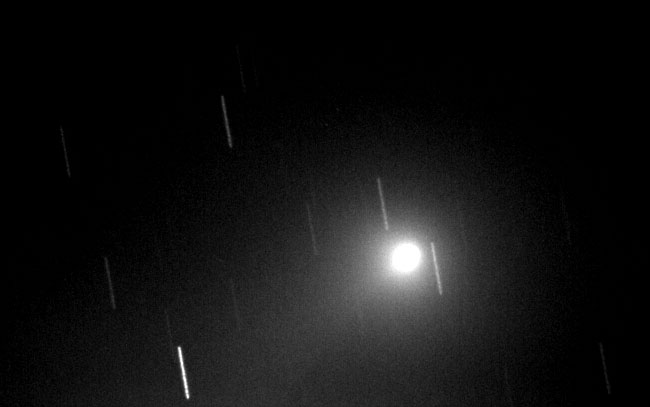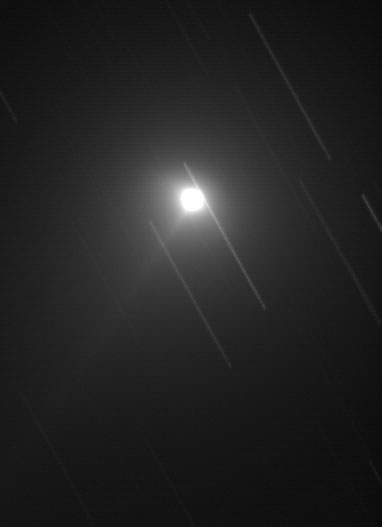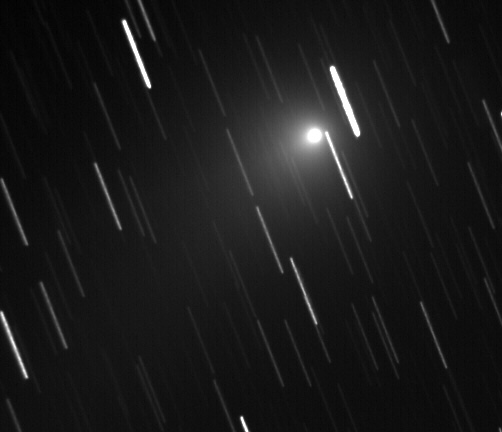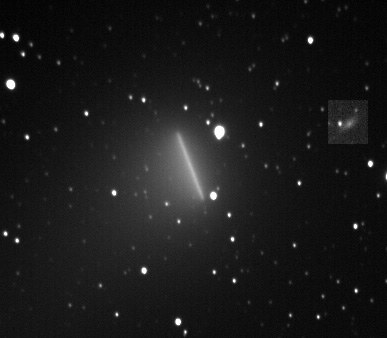I imaged Comet C/2001 A2/Linear on three different nights. The results of those efforts are arrayed below. All images are taken with an SBIG ST-7E camera, through the clear filter of a CFW-8 color filter wheel. My telescope is a 10" Meade LX200, native f/10. I use an NGF-S focuser (by JMI), and all images are taken with a Meade f/3.3 focal reducer without its extension tube, resulting in an effective focal ratio of f/4.6.
 |
July 8, 2001. This picture is the combination of 20 fifteen second images, unguided, combined using AIP4WIN. No other image processing performed, other than a small histogram stretch. The motion of the comet is toward the bottom of the picture (parallel with the star trails), and faint hints of the tail can be seen emanating from the coma at about 45 degrees toward the lower left. Unsteady skies, taken at dawn (literally, with lots of sky glow) on the morning of 7/8/01, at -18C. |
 |
July 13, 2001. This picture is the combination of 55 thirty second images, unguided, combined using AIP4WIN. No other image processing performed, other than a small histogram stretch. Again, the motion of the comet is toward the lower right (parallel with the star trails). This time, the tail is much more evident, emanating from the coma toward the lower left, although it seems to have thinned out a bit, and there seems to be a more pronounced "wake" around the coma. The comet lost more than a half magnitude of brightness between the two shots, from about 4.6 to about 5.2 (in five days). Very steady skies, taken just before dawn (I stopped when I saw sky glow building in the east) on the morning of 7/13/01, at -15C. |
 |
 |
July 25, 2001. These pictures are the combination of 30 one-minute images, guiding on a star, combined using AIP4WIN. No other image processing performed, other than a small histogram stretch. The picture on the left shows the images stacked, aligned on the comet. Again, the motion of the comet is toward the lower right (parallel with the star trails). This time, the tail is much less evident, emanating from the coma toward the lower left. The comet lost another magnitude and-a-half of brightness between July 13 and July 25, from about 5.2 to about 6.6, and it is much farther away. All images taken at -15C. The picture on the right was made by combining the same images, aligned on the stars, to show the motion of the comet during the time I was imaging. Also, note the galaxy in the field; the highlighted fuzzy object about a third of the way down near the right edge (in the box) is CGCG 449-14, a magnitude 15.3 spiral galaxy (thank you Software Bisque for the ability of CCDSoft and The Sky to link, so we can find information like that). Another oddity I noticed in the image is the odd shaped star to the right of the comet trail; why, I wondered, was this one oblong, when the others were reasonably round? The answer, it turns out (again thanks to Image Link), is that it is a double star (GSC1659:79, a pair of 10th magnitude stars).
Copyright Mark de Regt, 2006